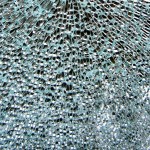
Preventing Glass Breakages
Shattering Safely
From windshields to coffee tables to high-rise office buildings, we are surrounded by glass. Glass can break when exposed to enough force.
Glass is already strong but can be even stronger by changing how it is made! Stronger glass could lead to higher durability. Stronger glass addresses one aspect of the glass safety issue, but all glass is destructible. Inevitably, even very strong glass will break under too much force.
Manufacturers use two main techniques for designing glass that breaks more safely:
• Laminated glass: The glass commonly used in windshields and high-rise windows is made by sandwiching a sheet of polyvinyl butyral (PVB) plastic between two or more pieces of glass and bonding them together under heat and pressure. Not only does this make the glass harder to break, but if the glass is broken, the broken pieces stick to the PVB.
This is why shattered windshields look like a spider web of broken pieces that don’t fall out, or if they do fall out, the whole windshield pops out in one piece. This property of laminated glass significantly reduces the risk of people being hurt from flying shards.
• Toughened or tempered glass: The glass used in shower doors and furniture undergoes a special heating and cooling process that strengthens the glass by five to 10 times. The tempering also reduces injuries–tempered glass shatters into tiny chunks instead of breaking into long, jagged splinters, reducing the severity and risk of injuries.







